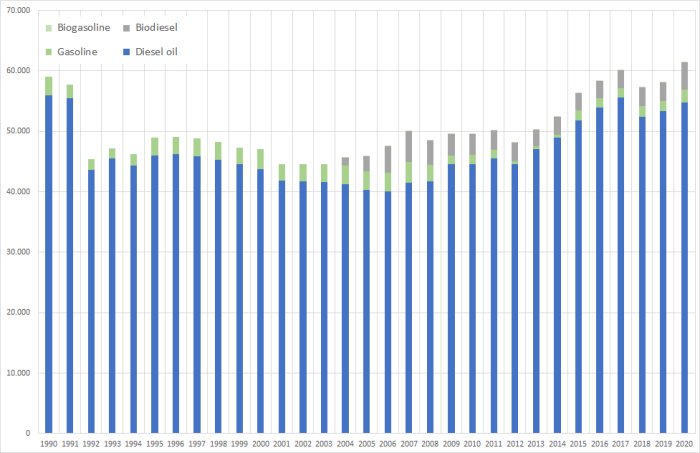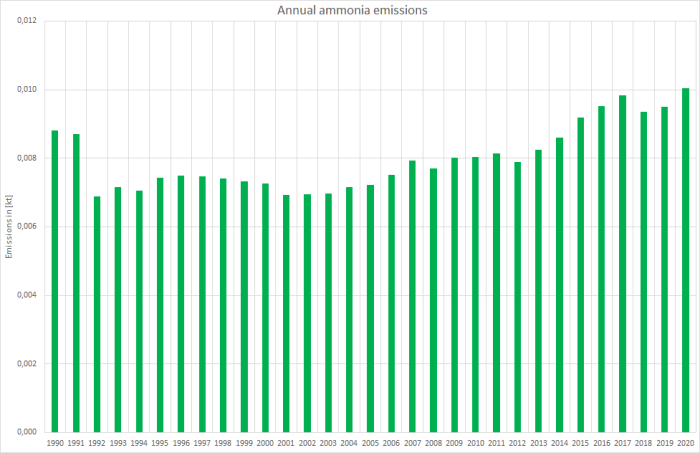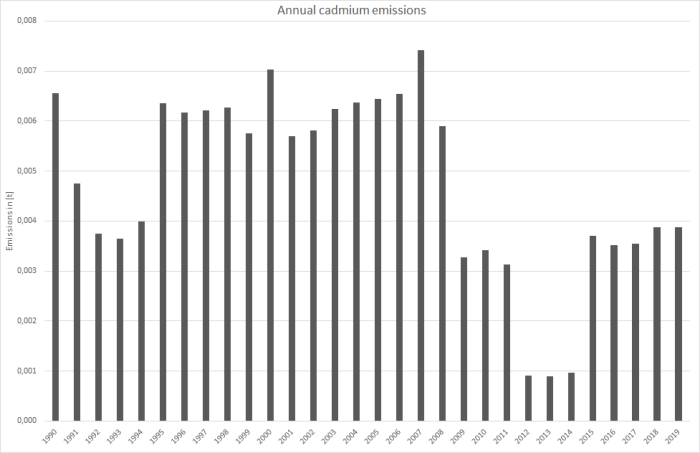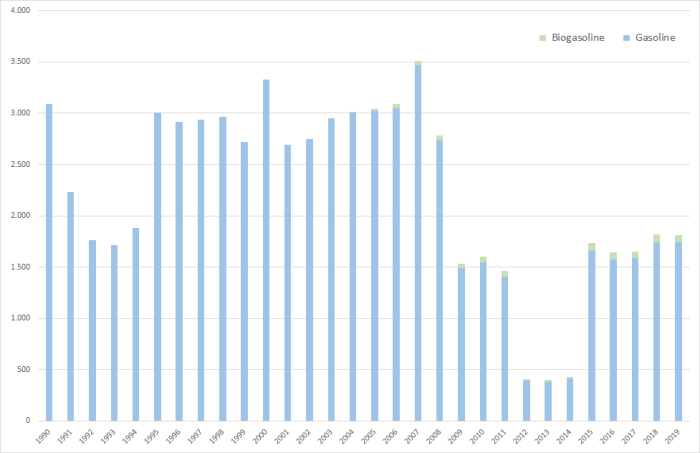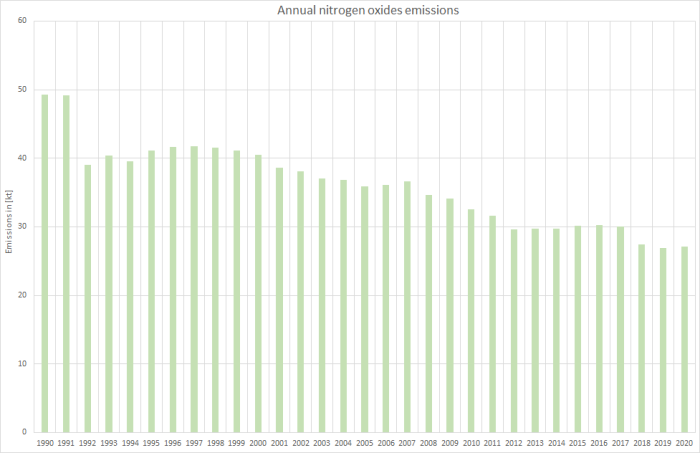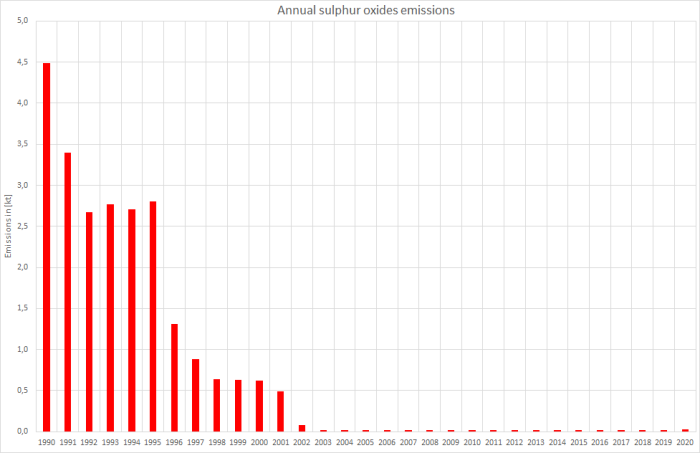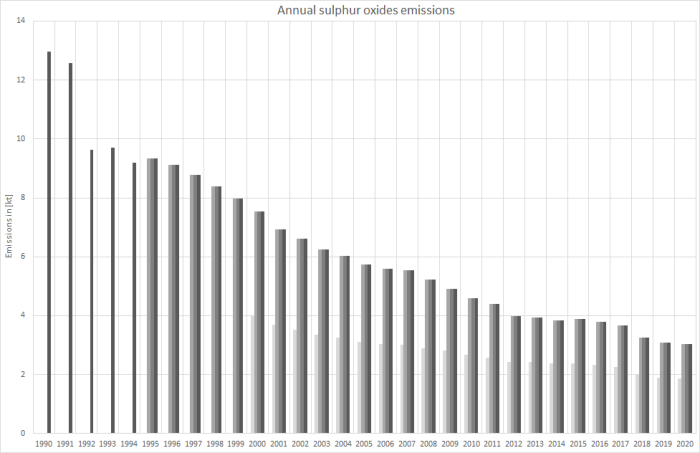meta data for this page
1.A.4.c ii - Agriculture/Forestry/Fishing: Off-Road Vehicles and Other Machinery
Short description
Under sub-category 1.A.4.c ii - Agriculture/Forestry/Fishing: Off-road Vehicles and other Machinery
 fuel combustion activities and resulting emissions from off-road vehicles and machinery used in agriculture and forestry are reported seperately.
fuel combustion activities and resulting emissions from off-road vehicles and machinery used in agriculture and forestry are reported seperately.
| NFR Code | Source category | Method | AD | EF | Key Category Analysis |
|---|---|---|---|---|---|
| 1.A.4.c ii | Agriculture/Forestry/Fishing: Off-Road Vehicles and Other Machinery | T1, T2 | NS, M | CS, D, M | L & T: BC, PM2.5, PM10 / L: NOx, |
| including mobile sources sub-categories | |||||
| 1.A.4.c ii (a) | Off-road Vehicles and Other Machinery: Agriculture | T1, T2 | NS, M | CS, D, M | - |
| 1.A.4.c ii (b) | Off-road Vehicles and Other Machinery: Forestry | T1, T2 | NS, M | CS, D, M | - |
Methodology
Activity data
Sector-specific consumption data is included in the primary fuel-delivery data are available from NEB line 67: 'Commercial, trade, services and other consumers' (AGEB, 2021) 1).

Table 1: Sources for primary fuel-delivery data
| through 1994 | AGEB - National Energy Balance, line 79: 'Haushalte und Kleinverbraucher insgesamt' | ||
| as of 1995 | AGEB - National Energy Balance, line 67: 'Gewerbe, Handel, Dienstleistungen u. übrige Verbraucher' |
Following the deduction of energy inputs for military vehicles as provided in (BAFA, 2021) 2), the remaining amounts of gasoline and diesel oil are apportioned onto off-road construction vehicles (NFR 1.A.2.g vii) and commercial/institutional used off-road vehicles (1.A.4.a ii) as well as agriculture and forestry (NFR 1.A.4.c ii) based upon annual shares derived from TREMOD MM (Knörr et al. (2021b)) 3) (cf. superordinate chapter).
To provide more specific information on mobile sources in agriculture and forestry, the inventory compiler further devides NFR sector 1.A.4.c ii into 1.A.4.c ii (i) - NRMM in agriculture in and 1.A.4.c ii (ii) - NRMM in forestry.
Table 2: Annual percentual contribution of NFR 1.A.4.c ii to the primary fuel delivery data provided in NEB line 67
| 1990 | 1995 | 2000 | 2005 | 2010 | 2011 | 2012 | 2013 | 2014 | 2015 | 2016 | 2017 | 2018 | 2019 | 2020 | |
| Diesel fuels | |||||||||||||||
|---|---|---|---|---|---|---|---|---|---|---|---|---|---|---|---|
| 1.A.4.c ii (i) | 47.6% | 45.6% | 43.9% | 46.2% | 47.5% | 47.2% | 47.3% | 48.0% | 47.8% | 48.3% | 48.5% | 48.5% | 48.4% | 48.4% | 48.3% |
| 1.A.4.c ii (ii) | 2.41% | 1.36% | 2.16% | 2.88% | 2.92% | 2.99% | 2.77% | 2.76% | 2.81% | 2.89% | 2.72% | 2.79% | 3.35% | 3.54% | 4.16% |
| Gasoline fuels 1 | |||||||||||||||
| 1.A.4.c ii (ii) | 68.5% | 40.3% | 44.9% | 41.4% | 35.5% | 35.6% | 33.1% | 32.9% | 33.1% | 33.3% | 31.6% | 31.9% | 35.8% | 36.8% | 40.4% |
source: own estimations based on Knörr et al. (2021b) 4) 1 no gasoline used in agriculatural vehicles and mobile machinery
Table 3: Annual mobile fuel consumption in agriculture and forestry, in terajoules
| 1990 | 1995 | 2000 | 2005 | 2010 | 2011 | 2012 | 2013 | 2014 | 2015 | 2016 | 2017 | 2018 | 2019 | 2020 | |
| Diesel oil | 55,958 | 45,954 | 43,747 | 40,309 | 44,606 | 45,576 | 44,609 | 47,090 | 48,977 | 51,836 | 53,891 | 55,585 | 52,399 | 53,310 | 54,791 |
|---|---|---|---|---|---|---|---|---|---|---|---|---|---|---|---|
| Biodiesel | 3,093 | 3,004 | 3,325 | 3,029 | 1,568 | 1,430 | 415 | 405 | 432 | 1,679 | 1,591 | 1,601 | 1,795 | 1,707 | 2,131 |
| Gasoline | 0 | 0 | 0 | 2,576 | 3,420 | 3,180 | 3,148 | 2,793 | 3,010 | 2,835 | 2,857 | 2,967 | 3,046 | 3,036 | 4,551 |
| Biogasoline | 0 | 0 | 0 | 20.8 | 60.6 | 58.6 | 18.4 | 17.3 | 18.8 | 72.8 | 69.1 | 67.5 | 80.7 | 73.6 | 97.3 |
| Ʃ 1.A.4.c ii | 59,051 | 48,958 | 47,071 | 45,936 | 49,655 | 50,245 | 48,190 | 50,304 | 52,438 | 56,423 | 58,409 | 60,220 | 57,320 | 58,128 | 61,571 |
Emission factors
The emission factors applied here are of rather different quality:
Basically, for all main pollutants, carbon monoxide and particulate matter, annual IEF modelled within TREMOD MM are used, representing the sector's vehicle-fleet composition, the development of mitigation technologies and the effect of fuel-quality legislation.
For Information on the country-specific implied emission factors applied to mobile machinery in agriculture and forestry, please refer to the respective sub-chapters linked above.
For information on the emission factors for heavy-metal and POP exhaust emissions, please refer to Appendix 2.3 - Heavy Metal (HM) exhaust emissions from mobile sources and Appendix 2.4 - Persistent Organic Pollutant (POP) exhaust emissions from mobile sources.
Discussion of emission trends
Table: Outcome of Key Catgegory Analysis
| for: | NOx | PM2.5 | PM10 | BC |
|---|---|---|---|---|
| by: | Level | L | L | Level & Trend |
NFR 1.A.4.c ii is key source for emissions of NOx, BC, PM2.5 and PM10.
Unregulated pollutants (Ammonia, HMs, POPs, ...)
For all unregulated pollutants, emission trends directly follow the trend in fuel consumption.
Here, exemplary for cadmium, the extreme steps in emission estimates result from two effects:
(i) the annual amounts of gasoline fuels allocated to NFR 1.A.4.c ii depend on the amounts delivered to the military also covered in NEB line 67. (see superordinate chapter for further information). This approach results in strong declines in gasoline consumption after 2007 and 2011 followed by an increase after 2014. In addition, in contrast to the main pollutants, all heavy-metal and POP emissions are calculated based on default EF from 5).
Table 4: Development of gasoline consumption in NFR 1.A.4.c ii, in terajoules
| 2010 | 2011 | 2012 | 2013 | 2014 | 2015 | 2016 | 2017 | 2018 | 2019 | |
|---|---|---|---|---|---|---|---|---|---|---|
| Gasoline | 1.543 | 1.404 | 392 | 383 | 412 | 1.660 | 1.575 | 1.588 | 1.741 | 1.739 |
| Biogasoline | 60 | 58 | 17 | 16 | 18 | 72 | 68 | 67 | 78 | 75 |
(ii) All gasoline fuels allocated to NFR 1.A.4.c ii are used in 2-stroke-engines in forestry equipment. As the 2-stroke fuel also includes lubricant oil, the fuel's heavy metal content is significantly higher than that of 4-stroke gasoline (or diesel fuels). (see Appendix 2.3 for more information on the reporting of HM emissions.)
Table 5: Tier1 default emission factors applied to NRMM, in g/TJ
| Pb | Cd | Hg | As | Cr | Cu | Ni | Se | Zn | |
|---|---|---|---|---|---|---|---|---|---|
| Diesel oil | 0.012 | 0.001 | 0.123 | 0.002 | 0.198 | 0.133 | 0.005 | 0.002 | 0.419 |
| Biodiesel1 | 0.013 | 0.001 | 0.142 | 0.003 | 0.228 | 0.153 | 0.005 | 0.003 | 0.483 |
| Gasoline fuels - 4-stroke | 0.037 | 0.005 | 0.200 | 0.007 | 0.145 | 0.103 | 0.053 | 0.005 | 0.758 |
| Gasoline fuels - 2-stroke2 | 0.051 | 2.10 | 0.196 | 0.007 | 8.96 | 357 | 14.7 | 2.09 | 208 |
| LPG (1.A.4.a ii only) | NE | ||||||||
1 values differ from EFs applied for fossil diesel oil to take into account the specific NCV of biodiesel 2 including the HM of 1:50 lube oil mixed to the gasoline Hence, emission estimates reported for cadmium are significantly higher for years with higher gasoline use (in 2-stroke enignes).
Regulated pollutants
For all regulated pollutants, emission trends follow not only the trend in fuel consumption but also reflect the impact of fuel-quality and exhaust-emission legislation.
Particulate matter & Black carbon
Over-all PM emissions are by far dominated by emissions from diesel oil combustion with the falling trend basically following the decline in fuel consumption between 2000 and 2005. Nonetheless, the decrease of the over-all emission trend was and still is amplified by the expanding use of particle filters especially to eliminate soot emissions.
Additional contributors such as the impact of TSP emissions from the use of leaded gasoline (until 1997) have no significant effect onto over-all emission estimates.
Recalculations
Revisions in activity data result from revised activity data for gasoline used in military vehicles (entire timeseries; see NFR 1.A.5.b) as well as the implementation of primary activity data from the now finalised NEB 2019.
Table 6: Revision of annual activity data, in terajoules
| 1990 | 1995 | 2000 | 2005 | 2006 | 2007 | 2008 | 2009 | 2010 | 2011 | 2012 | 2013 | 2014 | 2015 | 2016 | 2017 | 2018 | 2019 | |
|---|---|---|---|---|---|---|---|---|---|---|---|---|---|---|---|---|---|---|
| DIESEL FUELS | ||||||||||||||||||
| Submission 2022 | 55,958 | 45,954 | 43,747 | 42,885 | 44,476 | 46,614 | 45,687 | 48,092 | 48,026 | 48,756 | 47,757 | 49,883 | 51,987 | 54,671 | 56,749 | 58,552 | 55,445 | 56,347 |
| Submission 2021 | 55,958 | 45,954 | 43,747 | 42,885 | 44,476 | 46,614 | 45,687 | 48,092 | 48,026 | 48,756 | 47,757 | 49,883 | 51,987 | 54,671 | 56,749 | 58,552 | 55,448 | 56,246 |
| absolute change | 0,00 | 0,00 | 0,00 | 0,00 | 0,00 | 0,00 | 0,00 | 0,00 | 0,00 | 0,00 | 0,00 | 0,00 | 0,00 | 0,00 | 0,00 | -0,07 | -3,11 | 101,05 |
| relative change | 0,00% | 0,00% | 0,00% | 0,00% | 0,00% | 0,00% | 0,00% | 0,00% | 0,00% | 0,00% | 0,00% | 0,00% | 0,00% | 0,000% | 0,000% | 0,00% | -0,01% | 0,18% |
| GASOLINE FUELS | ||||||||||||||||||
| Submission 2022 | 3,093 | 3,004 | 3,325 | 3,050 | 3,104 | 3,522 | 2,799 | 1,552 | 1,629 | 1,488 | 433 | 422 | 451 | 1,752 | 1,660 | 1,668 | 1,875 | 1,781 |
| Submission 2021 | 3,093 | 3,004 | 3,325 | 3,043 | 3,090 | 3,511 | 2,786 | 1,534 | 1,603 | 1,462 | 409 | 400 | 430 | 1,732 | 1,644 | 1,655 | 1,819 | 1,814 |
| absolute change | 0,00 | 0,00 | 0,00 | 7,57 | 14,2 | 11,8 | 13,8 | 18,2 | 25,9 | 26,6 | 23,8 | 22,4 | 20,6 | 19,3 | 16,5 | 13,4 | 56,5 | -33,4 |
| relative change | 0,00% | 0,00% | 0,00% | 0,25% | 0,46% | 0,34% | 0,50% | 1,19% | 1,62% | 1,82% | 5,81% | 5,60% | 4,79% | 1,11% | 1,00% | 0,81% | 3,11% | -1,84% |
| OVER-ALL FUEL CONSUMPTION | ||||||||||||||||||
| Submission 2022 | 59,051 | 48,958 | 47,071 | 45,936 | 47,580 | 50,136 | 48,486 | 49,644 | 49,655 | 50,245 | 48,190 | 50,304 | 52,438 | 56,423 | 58,409 | 60,220 | 57,320 | 58,128 |
| Submission 2021 | 59,051 | 48,958 | 47,071 | 45,928 | 47,565 | 50,124 | 48,472 | 49,626 | 49,629 | 50,218 | 48,166 | 50,282 | 52,417 | 56,404 | 58,392 | 60,207 | 57,267 | 58,060 |
| absolute change | 0,00 | 0,00 | 0,00 | 7,57 | 14,2 | 11,8 | 13,8 | 18,2 | 25,9 | 26,6 | 23,8 | 22,4 | 20,6 | 19,3 | 16,5 | 13,3 | 53,4 | 67,7 |
| relative change | 0,00% | 0,00% | 0,00% | 0,02% | 0,03% | 0,02% | 0,03% | 0,04% | 0,05% | 0,05% | 0,05% | 0,04% | 0,04% | 0,034% | 0,028% | 0,02% | 0,09% | 0,12% |
In contrast, all emission factors remain unrevised compared to last year's susbmission.
For pollutant-specific information on recalculated emission estimates for Base Year and 2019, please see the recalculation tables following chapter 8.1 - Recalculations.
Uncertainties
Uncertainty estimates for activity data of mobile sources derive from research project FKZ 360 16 023: “Ermittlung der Unsicherheiten der mit den Modellen TREMOD und TREMOD-MM berechneten Luftschadstoffemissionen des landgebundenen Verkehrs in Deutschland” by (Knörr et al. (2009)) 6).
Uncertainty estimates for emission factors were compiled during the PAREST research project. Here, the final report has not yet been published.
Planned improvements
Besides a routine revision of TREMOD MM, no specific improvements are planned.
FAQs
Why are similar EF applied for estimating exhaust heavy metal emissions from both fossil and biofuels?
The EF provided in 7) represent summatory values for (i) the fuel's and (ii) the lubricant's heavy-metal content as well as (iii) engine wear. Here, there might be no heavy metal contained the biofuels. But since the specific shares of (i), (ii) and (iii) cannot be separated, and since the contributions of lubricant and engine wear might be dominant, the same emission factors are applied to biodiesel and bioethanol.


